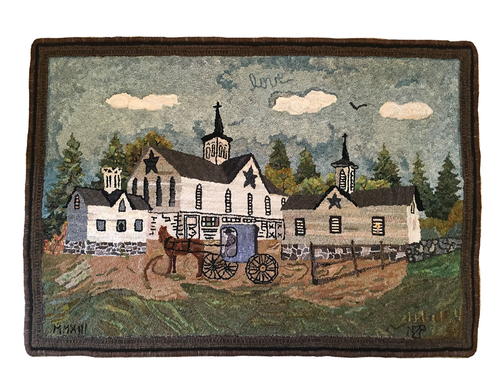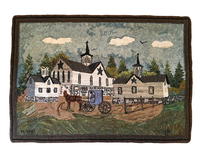Hooking Higgledy Piggledy
Ask the Experts: Go wild. Go antigodlin!

Pennsylvania Stars, 40" x 28", #3 to 6-cut wool on linen. Designed by Leonard Feenan and hooked by Nancy Z. Parcels, Rustburg, Virginia, 2013.
The sky is full of loops of color, and there are clouds. When the clouds are viewed up close, they do have several directional loops laid to give the cloud itself a bit of direction, creating depth within it. However, the rest of the sky was all hooked in antigodlin (with the exception of my message, sky writing about my feelings for Pennsylvania). Notice how the sky has many light and dark areas; the transition is made by use of color, not the direction of the loops. The sky was hooked in a hand-dyed #6 cut. Not all skies should be hooked in this method, but I urge you give it a try.
antigodlin (ante¦gädlen)
adjective
lopsided or at an angle; out of alignment
—Dictionary.com, s.v. "Antigodlin," accessed August 23, 2016. http://www.dictionary.com/browse/antigodlin.
In a hooked rug, the color of the wool loops and the direction in which the loops are pulled leads the viewer’s eye around the design. But sometimes a design calls for sections with no discernable direction in the hooked loops. That is when antigodlin comes into play.
What is antigodlin?
Antigodlin, also know as “higgledy piggledy,” is a hooking technique that allows us to fill a shape without direction. Imagine you are hooking a circle. First, you outline it, and then you fill in, hooking around and around until you reach the center. When you look at the finished rug, your eye would surely follow that circular motion of the loops. Now imagine you have the same circle and a handful of rice. When you throw the grains down into that circle, they will fill that shape, but each grain will land pointing in a different direction. That random direction of the grains is an example of antigodlin.
The lovely, talented June Mikoryak introduced me to the antigodlin technique at the Caraway Rug School where I began working on Large Frost Oriental OSV-134. Orientals are hooked on the diagonal to mimic the back-and-forth weaving of the original rugs. However, some of the outer fields and small borders in my rug did not leave enough room to work the back-and-forth method, so I filled in these areas using the antigodlin style.
How do you hook antigodlin?
First, think of the point of your hook as the point of a compass. The direction the point comes out of the foundation is the way the loop will lay. When hooking antigodlin, the objective is to make sure no two loops lie in the same direction. So pull up a loop, remove your hook, turn your hook, then pull up the next loop. This second loop lands in a different direction. Think of it as building little bunches of wool loops. It will feel a little odd at first because we are breaking that rule of having our pretty little loops all line up. But the mixed-up look is what we want.
I have hooked antigodlin with strips of #3-cut wool up to # 8-cut wool.
When would you use antigodlin?
Choose the antigodlin technique anytime you want to fill a shape so the eye only sees the shape and color but is not led in a particular direction. The center of a flower is a perfect example. Another example is a sky when you don’t want to direct the viewer’s eye back and forth or up and down (see Pennsylvania Stars).
The technique works very well with spot-dyed wool as the loops of color capture the light’s reflection in different ways, almost producing a shimmer. With a textured wool, this method fills the area nicely as textures bloom a bit when hooked and do not hold a crisp line.
Take the time to look at what I call “the big picture” when you are using the antigodlin technique. When we are working on our rugs, they are close to our face; when completed, they will be viewed from a distance. So every so often, remove your rug from the frame and view it from farther away. The colors, the shapes, the loops and their direction (or lack thereof) will now appear as you will see the rug when it’s finished. If you can’t move your rug, try using a reducing glass to see your rug from afar while it is still on your frame. A peephole for a door makes a simple, portable reducing glass.
Many old and antique hooked rugs were hooked in antigodlin. The utilitarian rugs, made by untrained hands to cover the dirt floors in early homes, were made by homemakers looking for a way to use up the old clothing scraps and cover the cold floor. The next time you have an element to fill, consider using the antigodlin technique. You can give the viewer’s eye a break and, at the same time, add interest to your rug.
Nancy Z. Parcels is a McGown accredited teacher. She currently lives in southern Virginia and teaches from her home and at workshops and guilds. Four of her rugs have been selected for Celebration, and she enjoys writing for Rug Hooking magazine.
This article excerpt is from the September/October 2016 issue. For more information on our issues, check out our issues page.



